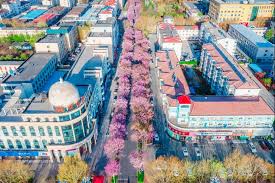Letter from China: Experience thriving aviation industry in east China town

Hefei: “Without leaving the town, we can make homegrown general aviation aircraft here.” This was the most common response I received from the locals during my visit to Wanzhi Township of Wuhu City, east China’s Anhui Province, earlier this year.
Nestled along the Yangtze River, this emerging aviation town, dozens of kilometers from Wuhu’s urban area, is home to more than 140 aviation companies, including aircraft parts manufacturers, final assemblers and operation and maintenance companies.
Driven by my curiosity over the town’s success, I visited the first aviation company established here. As I walked through the modern factory and cool exhibition halls, it was hard to imagine that most of the town was once a wasteland.
At the CETC Wuhu Diamond Aircraft Manufacture Co., Ltd., a group of young engineers were installing different parts on the fuselage of a white four-seat aircraft. Outside the workshop, the assembled aircraft was undergoing test flights on the long test runway with the roaring sounds of the engines echoing.
“About 10 years ago, CETC decided to collaborate with Wuhu City to establish the company here thanks to a newly approved airport and the city’s automobile manufacturing prowess,” said Wang Tao, who works for CETC Wuhu Diamond.
From introducing foreign production lines to independently developing new aircraft, the company has delivered over 100 aircraft to customers nationwide.
Over the past years, more companies have joined and witnessed the town’s rapid development. Yan Huaiqiang, general manager of Wuhu United Aircraft Technology Co., Ltd., shared his story.
“Before deciding to establish the subsidiary here, we had inspected Wanzhi several times and the change here is undoubtedly huge,” said Yan. “New factories are springing up. The increasingly complete industrial chain, excellent business environment and talent policy are quite alluring to us.”
Riding the wave of the low-altitude economy, the company has developed a wide range of unmanned aerial vehicles for logistics, emergency rescue and air patrol.
“The low-altitude economy is on a fast track of growth with the support of policies and regulations as well as mature technologies. The output value of our company is expected to be no less than 200 million yuan (about 28 million U.S. dollars) in 2024,” said Yan, adding that they are expanding capacity to meet market demand.
Data from the Civil Aviation Administration of China backs up Yan’s words. The size of China’s low-altitude economy is expected to reach 2 trillion yuan in 2030 from some 500 billion yuan in 2023.
As an important field for fostering China’s new quality productive forces, this emerging industry enjoys broad prospects. This town has already witnessed the boom of the industry as upstream and downstream companies gather here.
In the exhibition hall of Wuhu Diamond Aero Engine Co., Ltd. (WDAE), Zheng Jun, general manager of the company and also a senior engineer, introduced us to their self-developed aircraft engines with great passion and pride.
“Since 2016, we have gone through more than 300 development and airworthiness validation flight tests and overcome many technical challenges and obtained the type certificate issued by the Civil Aviation Administration of China in 2023,” said Zheng.
In the WDAE factory, robots are assigned to perform various tasks, and automated guided vehicles transport materials in an orderly manner, helping to make mass production of engines more efficient.
This year, WDAE has received orders for nearly 500 engines, some of which will be supplied to nearby aircraft companies.
Interestingly, the propellers that match the WDAE’s aircraft engines also come from a company just a few kilometers away.
“Like many peers in the town, we are both suppliers and customers,” said Zheng, adding that cooperative development allows them to reduce costs and accelerate innovation.
From engines to avionics, propellers to raw materials, a whole chain of the general aviation industry has taken shape in Wanzhi, attracting talents from across the country to pursue their dreams here. In recent years, more than 800 aviation innovation talents have flocked to this once little-known place.
Wanzhi is just one of many Chinese towns charting their economic development paths based on their unique strengths and conditions.
In recent years, I have visited many unique towns, such as the wedding dress town, the brush-making town and the cable town. These towns have told excellent stories of upgrading and transformation amid China’s rural revitalization and burgeoning economic growth.





